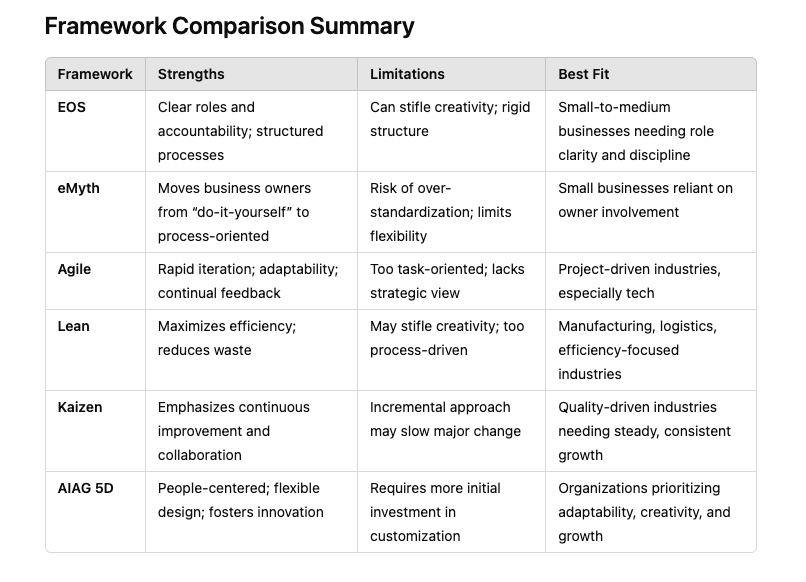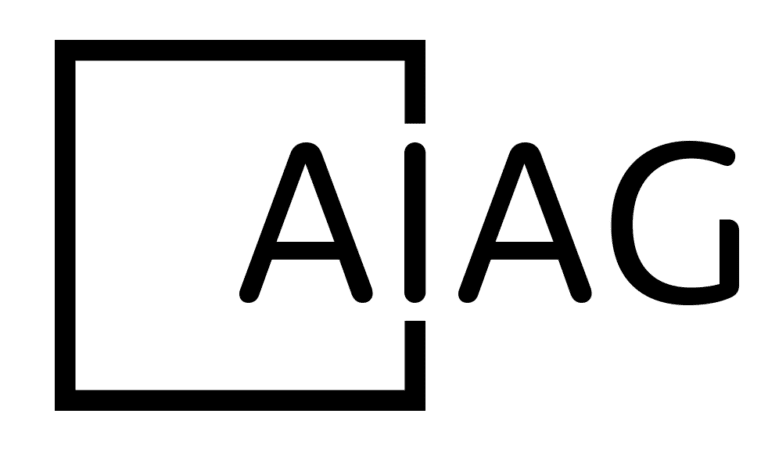In an evolving business landscape, frameworks like EOS, eMyth, Agile, Lean, Kaizen, and AIAG’s 5D process provide structure and process, aiming to foster growth and innovation. While each framework offers valuable strategies, it also has limitations. Here, we’ll delve deeper into each framework’s strengths, limitations, and where each might fit best.
1. Entrepreneurial Operating System (EOS)
Strengths:
EOS organizes companies around six core components: vision, people, data, issues, process, and traction. This structure helps leaders clarify roles, set measurable goals, and track progress. EOS is particularly effective at creating alignment and focus by requiring teams to establish clear priorities and identify “rocks,” or critical objectives, that need to be met quarterly. This level of clarity and accountability can empower employees, helping reduce ambiguity and drive productivity.
Limitations:
EOS’s heavy emphasis on structure can make it feel rigid for companies that thrive on flexibility or require rapid adaptability. The highly standardized process can sometimes pigeonhole employees, limiting their ability to think beyond assigned roles or pursue innovative ideas. EOS works best in a stable environment where consistency is key, but it may limit creativity and experimentation in highly dynamic industries.
Best Fit:
EOS is well-suited for small-to-medium-sized companies that need greater structure, role clarity, and accountability. Businesses that require a streamlined and disciplined approach to achieve growth targets can find EOS a valuable tool.
2. eMyth
Strengths:
eMyth empowers business owners to create a business that can run independently of their direct involvement by emphasizing the importance of processes over people. By pushing business owners to work on the business rather than in it, eMyth helps small companies systematize their operations, which can lead to smoother day-to-day management, especially as the business grows. It provides a roadmap for creating repeatable processes that ensure consistency and allow for scaling.
Limitations:
While eMyth is effective at helping companies standardize operations, it may risk stifling the unique creativity and entrepreneurial spirit that led to the business’s success in the first place. The process-centric nature of eMyth may make it challenging to adapt to rapidly changing markets or to integrate innovative practices, as it can foster a focus on “doing things the right way” instead of exploring new approaches.
Best Fit:
eMyth works well for small businesses transitioning from owner-reliant operations to a more scalable model. It is ideal for organizations that need strong foundational processes to enable growth but may be less suitable for companies in fast-paced or highly innovative fields.
3. Agile
Strengths:
Agile is highly adaptable and fosters a collaborative environment, breaking projects into smaller, manageable units that can be adjusted based on stakeholder feedback. Agile excels in dynamic and high-tech industries, where rapid iteration and continual feedback are crucial. By focusing on delivering incremental value through sprints, Agile can enhance responsiveness, build team collaboration, and adapt to changing requirements, making it valuable in project-based environments.
Limitations:
Agile’s strength in adaptability can also be a weakness, as it often lacks a long-term strategic view. The framework can lead to fragmented results if the organization does not have a clear overarching strategy, with teams too focused on meeting short-term goals and missing the bigger picture. Agile can also create challenges when applied to departments beyond product or project teams, where a more consistent structure is needed.
Best Fit:
Agile is ideal for tech-driven industries, particularly software development, where constant iteration and adaptation are required. It is most effective in environments that benefit from flexibility, rapid delivery, and ongoing stakeholder engagement.
4. Lean
Strengths:
Lean aims to maximize value by eliminating waste, enhancing efficiency, and focusing on value-added activities. The Lean approach is heavily process-oriented and works well in environments that prioritize quality and cost-effectiveness. By constantly refining processes, Lean fosters a mindset of continuous improvement, helping businesses reduce redundancies, improve flow, and create more efficient operations, making it a strong choice for manufacturing and operational industries.
Limitations:
Lean’s focus on waste reduction and efficiency can inadvertently stifle creativity and experimentation. Its process-driven nature can make it difficult to foster a culture of innovation, as Lean principles often emphasize minimizing resources and optimizing existing processes rather than exploring new ideas. This framework is best suited for optimizing established processes but may not provide the flexibility needed in rapidly changing or innovation-driven industries.
Best Fit:
Lean is an excellent fit for manufacturing, supply chain, and industries where operational efficiency and resource optimization are essential. It excels in structured, highly regulated environments but may feel restrictive for creative or innovation-focused organizations.
5. Kaizen
Strengths:
Kaizen is a philosophy of continuous improvement through small, incremental changes. By engaging employees at all levels, Kaizen fosters a culture of improvement and collaboration, making it ideal for organizations that want to empower their workforce and prioritize long-term quality. Kaizen emphasizes everyone’s role in contributing ideas for improvement, which can build morale and commitment. Its focus on incremental, consistent change promotes sustainable growth and can lead to strong, cumulative improvements over time.
Limitations:
Kaizen’s incremental approach means it can be slow to deliver transformative results, making it less suitable for companies needing rapid or disruptive change. Its emphasis on gradual improvement may cause resistance when larger changes or innovative solutions are required. Kaizen may also struggle in environments where the organization’s culture is not open to bottom-up involvement or where leaders resist changing their traditional management approaches.
Best Fit:
Kaizen is ideal for companies aiming to foster a culture of steady, incremental improvement, with a strong emphasis on quality and workforce engagement. It is particularly valuable in quality-driven industries where long-term growth and sustained progress are prioritized over rapid transformation.
6. AIAG’s 5D Process
Strengths:
The 5D process (Destination, Discovery, Define, Design, Develop) from AIAG combines the benefits of structure with a people-centered approach. This process aligns organizational goals with the strengths of the team members, emphasizing adaptability, vision, and creativity. Unlike traditional frameworks that can feel rigid, the 5D process provides a structured roadmap that can be customized to foster innovation and growth, addressing the dynamic needs of modern businesses.
Destination: Sets a clear vision and goals.
Discovery: Assesses current strengths, areas for improvement, and cultural fit.
Define: Outlines systems and human-centered strategies needed to reach goals.
Design: Develops a customized plan, selecting frameworks to fit company culture.
Develop: Builds tailored solutions that empower teams, balancing structure and creativity.
Limitations:
While the 5D process may require more upfront investment in time and resources due to its customization, it also helps identify when businesses may benefit from taking a hybrid approach or implementing other solutions at different stages of maturity. This avoids the common pitfall of making significant changes or implementing a framework that may not be the best fit, ultimately protecting both resources and morale.
Best Fit:
The 5D process is ideal for organizations that value adaptability, creativity, and people-centered innovation. It’s particularly effective for companies aiming to balance structured processes with a flexible, human-centered approach to change and growth.

Final Thoughts
Each of these frameworks provides unique strengths and addresses specific organizational needs. EOS, eMyth, Agile, Lean, and Kaizen bring structure, accountability, and efficiency but may limit flexibility and innovation when applied too rigidly. AIAG’s 5D process offers a balanced approach that fosters innovation, adaptability, and growth by prioritizing people alongside processes.
The right framework depends on your organization’s needs—whether you seek structure, efficiency, adaptability, or a people-centered culture of innovation. A clear understanding of each framework’s strengths and limitations allows you to make an informed choice, using the tools that best support sustainable growth and long-term success.





